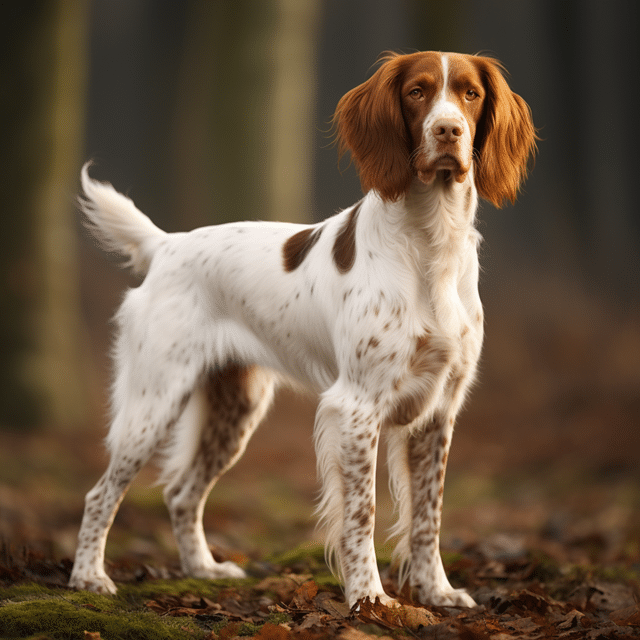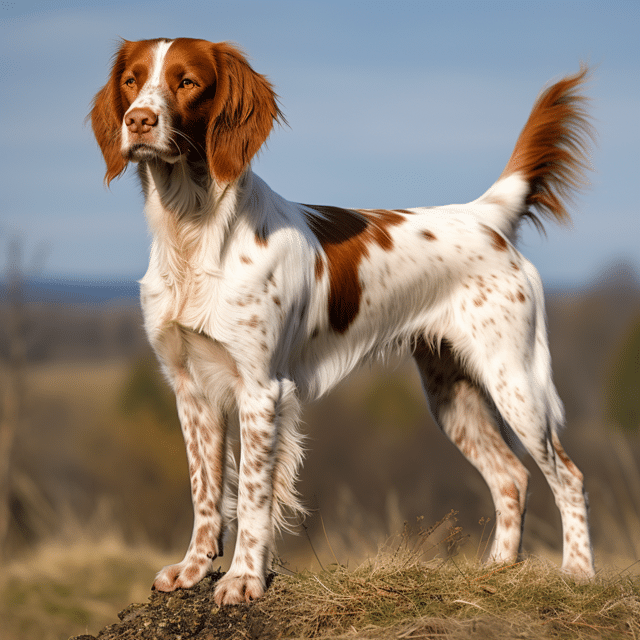Are Brittany Dogs Born Without Tails?: Like unwrapping a mysterious gift, you’re about to delve into the intriguing world of Brittany dogs. You’ll unravel the genetic quirks that might leave these charming canines tailless from birth. We’ll also touch on tail docking practices, health implications, and breeding standards. So, are Brittanys born without tails? Let’s find out.
The Brittany Tail: A Close Look
Let’s delve into the distinctive characteristics of a Brittany dog’s tail, which often stir curiosity in dog enthusiasts. The Brittany’s tail, or lack thereof, is an intriguing marker of breed identification. Many Brittanys are born with tails that are naturally short or absent, a trait known scientifically as anury or brachyury. This is not a defect but a genetic trait, tied to the breed’s lineage.
Tail symbolism in the canine world is significant. Tails serve as a communication tool, expressing emotions and intentions. Yet, the absence of a tail doesn’t hamper a Brittany’s ability to communicate. They compensate with other body language, including postures and ear movements.
Still, the Brittany’s tail isn’t always absent. Some are born with a full-length tail, which is typically docked to a length of 1-4 inches for various reasons, predominantly historical hunting purposes. Tail docking, though controversial, was originally done to prevent injury as the dogs moved through heavy brush. Today, it’s more about breed standards and aesthetics.
The Brittany’s tail is a fascinating study of genetics, breed identification, and tail symbolism. Whether naturally short, absent, or docked, it does not deter these dogs from being the energetic, loving companions they are known to be. Their tail, or lack thereof, contributes to their uniqueness, making them stand out in the canine crowd.
Genetic Traits of Brittany Dogs
While you’re marveling at the Brittany’s unique tail, it’s worth noting that this breed carries other remarkable genetic traits that make them stand out. These traits, including Brittany Temperament Traits, Brittany Coat Colors, and Brittany Lifespan Expectancy, contribute significantly to the breed’s overall appeal.
- Brittany Temperament Traits: Brittany dogs are known for their high energy, intelligence, and eagerness to please. This breed is extremely trainable, making them excellent working dogs in hunting and field trials. They’re typically good with children and other dogs, although they can be a bit reserved with strangers. Their high energy levels require substantial exercise to prevent behavioral issues.
- Brittany Coat Colors: Another fascinating genetic trait of Brittany dogs is their beautiful coat colors. The most common colors are orange and white or liver and white. However, variations can occur, such as roan patterns or tri-color (white, orange, and black). Their coat is dense to protect them from briars in the field, but it’s also wavy and feathering, giving them a unique, appealing appearance.
- Brittany Lifespan Expectancy: Brittany dogs are generally healthy and robust, with a typical lifespan expectancy of 12 to 14 years. However, it’s not unusual for a Brittany to live beyond this range with good care and regular veterinary check-ups. They’re prone to certain genetic health conditions, such as hip dysplasia and epilepsy. Therefore, responsible breeding practices are crucial to maintaining the breed’s health.
Understanding these genetic traits can help you appreciate the Brittany breed even more. It’s not just about their tail, but a combination of traits that make them the beloved breed they are today.

Understanding Brittany Dog Breed
Now that you’ve learned about these three key genetic traits, it’s essential to delve deeper into understanding the Brittany dog breed as a whole. This breed’s history, temperament, and hunting abilities all contribute to what makes this dog unique.
The Brittany breed has a history that dates back to the 17th century in Brittany, a region in northwestern France. Originally bred for hunting small game like birds, the breed is known for its exceptional agility, keen sense of smell, and tireless energy. They’re compact, athletic dogs with a natural affinity for hunting, making them a favorite among sportsmen and women worldwide.
Brittany’s temperament is a blend of intelligence, eagerness, and a friendly nature. They’re known for being highly trainable, making them excellent working dogs. But they’re also great family pets, thanks to their affectionate and sociable disposition. Despite their hunting background, they’re not aggressive. They’re usually good with children and other pets, although early socialization is always recommended.
Speaking of hunting abilities, the Brittany is unmatched. Their compact size and athletic build give them great speed and endurance in the field. They’re equally comfortable on land and in water, making them versatile hunters. Their keen sense of smell and high prey drive make them excellent at tracking and retrieving game. This breed thrives on physical and mental stimulation, so a job like hunting or agility training keeps them happy and healthy.
Understanding the Brittany dog breed requires an appreciation for their history, temperament, and hunting abilities. These elements combine to create a breed that’s both a capable hunter and a loving family pet.
Tail Docking Practices Explained
Diving into the topic of tail docking, you’ll find it’s a practice often associated with Brittany dogs, but it’s crucial to understand that they aren’t born without tails. Tail docking is a surgical procedure to remove part or all of a dog’s tail. The practice is prevalent in certain breeds for historical reasons, often related to perceived functionality or breed standards.
Understanding the docking controversy requires a deep dive into three main areas:
- Historical Context: Tail docking started centuries ago, when people believed it could prevent rabies, improve a dog’s speed, and prevent injuries for working dogs. Today, it’s more about maintaining a breed’s traditional look.
- Ethical Considerations: There’s a growing debate about the ethical implications of tail docking. Critics argue that it’s unnecessary, painful, and deprives dogs of a vital communication tool. Proponents, however, believe it can prevent potential tail injuries, especially in hunting or working breeds.
- Tail Functionality: A dog’s tail serves important functions. It helps maintain balance, especially when running or swimming. It’s also a critical communication tool, as dogs use their tails to express various emotions.
In the case of Brittany dogs, tail docking is traditionally done to prevent injuries while hunting in dense vegetation. However, this practice is increasingly scrutinized due to ethical considerations and the understanding of tail functionality. Some countries have even banned tail docking, underscoring the need for a science-based, welfare-conscious approach to this issue. It’s important to make informed decisions based on current veterinary science, ethical considerations, and breed-specific needs.
Health Implications of Taillessness
In considering a tailless Brittany dog, you should be aware of the potential health implications. Tailless health risks include spinal disorders and altered pain perception due to the absence of a tail.
Spinal disorders are a significant concern for tailless dogs. The tail is an extension of the spine, and its absence could affect the dog’s balance, coordination, and movement. This could lead to spinal issues over time, causing discomfort and even pain for the dog.
Altered pain perception is another issue. A tail acts as a sensory organ, sending signals to the dog’s brain about its surroundings. Without a tail, these signals may be disrupted, potentially affecting the dog’s perception of pain and other sensations.
Here’s a table that highlights some key health implications of taillessness:
| Health Implication | Description | Potential Impact |
|---|---|---|
| Spinal Disorders | Issues with balance, coordination, and movement | Discomfort, pain, reduced mobility |
| Altered Pain Perception | Disrupted sensory signals | May affect perception of pain and other sensations |
| Anxiety | Tail is used for communication; absence may cause stress | Behavioural issues, reduced social interaction |
| Incontinence | Tail helps with control of elimination | Potential for accidents, increased need for care |
| Reduced Swimming Ability | Tail aids in swimming | Increased risk of drowning |
It’s crucial to understand these potential health risks if you’re considering a tailless Brittany. With the right care and attention, these risks can be managed, ensuring your dog leads a happy and healthy life.
Tail-Related Breeding Standards
Often, when you’re considering a Brittany dog, you’ll encounter tail-related breeding standards that are crucial to understand. These standards delve into tail length variations, the docking controversy, and canine tail functions. Understanding these aspects can help you make informed decisions regarding your potential pet.
- Tail Length Variations: Brittany dogs naturally exhibit a range of tail lengths, from full-length tails to naturally bobbed ones. The breed standard, as set by organizations like the American Kennel Club (AKC), allows for tails approximately four inches in length, give or take an inch. However, it’s important to note that tail length doesn’t impact a Brittany’s health or agility.
- Docking Controversy: Tail docking, or surgically reducing a puppy’s tail length, is a controversial practice. Advocates argue that it’s a traditional aspect of the breed’s appearance and prevents hunting-related injuries. Critics, however, say it’s unnecessary and potentially harmful. Some countries have banned docking, meaning Brittanys in these regions will have their natural tails, regardless of length.
- Canine Tail Functions: A dog’s tail serves various functions, from aiding balance to communicating emotions. Brittanys, as active hunting dogs, use their tails for balance during high-speed pursuits. Their tails also help them convey their emotional state to their handlers. A docked tail may limit these functions, though it doesn’t significantly hinder the dog’s overall ability to communicate or maintain balance.
While tail-related issues might seem minor, they’re an integral part of the Brittany breed’s identity. Understanding these standards will help you appreciate the breed’s unique characteristics and make informed decisions about your future furry companion.

Frequently Asked Questions
What Is the Average Lifespan of a Brittany Dog?”
You’re curious about the average lifespan of a Brittany dog. Typically, these energetic dogs live between 10 and 14 years. However, their lifespan can be influenced by genetic health issues and breeding considerations. Regular vet check-ups are crucial to monitor their health and catch any potential problems early. With good care, they can live a full, healthy life. Remember, each dog is unique and individual care is vital to longevity.
How Often Should a Brittany Dog Be Groomed?”
You’re probably wondering how often your Brittany dog needs grooming. Well, it’s not as often as you’d think! With the right grooming tools, coat maintenance becomes a breeze. Brushing should be done twice a week to prevent matting. Bathing frequency depends on your dog’s activities, but usually once a month is sufficient. Regular grooming keeps your Brittany’s coat healthy and shiny. Remember, it’s not just about looking good, it’s about their overall health.
Are There Any Specific Dietary Requirements for Brittany Dogs?”
Yes, Brittany dogs do have specific dietary needs. You’ll need to consider their allergies impact, food preferences, and potential for Brittany obesity. They’re active dogs, so they require high-quality protein and fats for energy. Some may have allergies, so you’ll need to be mindful of their diet. As for their preferences, they’re not very picky but it’s important to introduce variety. Lastly, overfeeding can lead to obesity, so monitor their food intake closely.
What Kind of Temperament Do Brittany Dogs Typically Have?”
You’re curious about the temperament of Brittany dogs? They’re known for their intelligence, but this can present training challenges. They’re eager to please, yet their smarts mean they can be stubborn. Proper training requires patience and consistency. Additionally, Brittanys have high socialization needs. They thrive on companionship and don’t do well left alone for long periods. They’re friendly and good with children, making them a great family dog.
How Much Exercise Does a Brittany Dog Need on a Daily Basis?”
You’re wondering how much exercise your Brittany dog needs daily? It’s significant. They require at least an hour of vigorous activity. Brittany training techniques often include games due to their playful nature. Invest in dog exercise toys to keep them engaged. Canine fitness programs are also beneficial for their high energy levels. Remember, a well-exercised Brittany is a happy, healthy one. Ensure you’re meeting their exercise needs to maintain their physical and mental well-being.
Conclusion
So, you see, Brittany dogs aren’t born without tails. It’s a genetic trait for them to have shorter tails, but tail docking is often implemented. While taillessness doesn’t inherently cause health issues, docking can. Breed standards, though, still advocate for a specific tail length. It’s a fascinating coincidence, isn’t it? How nature’s design and human preferences intertwine to shape this charming breed. Always remember, understanding your dog’s genetics is key to their wellbeing.

